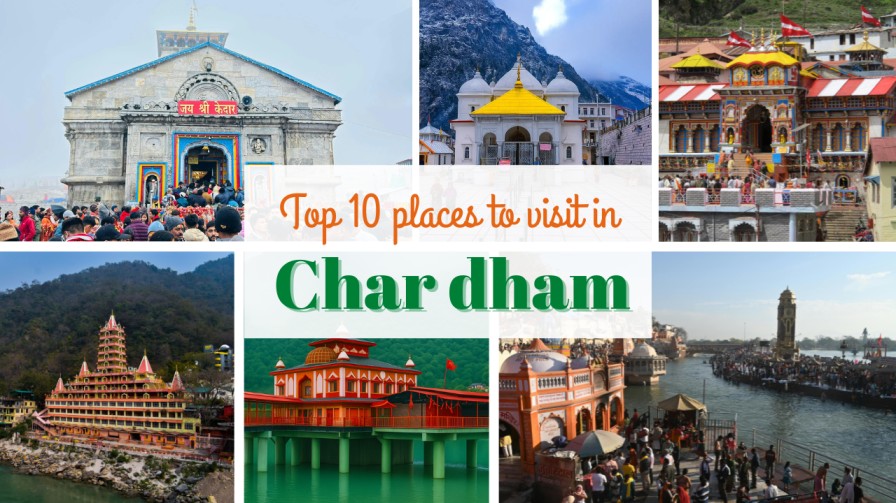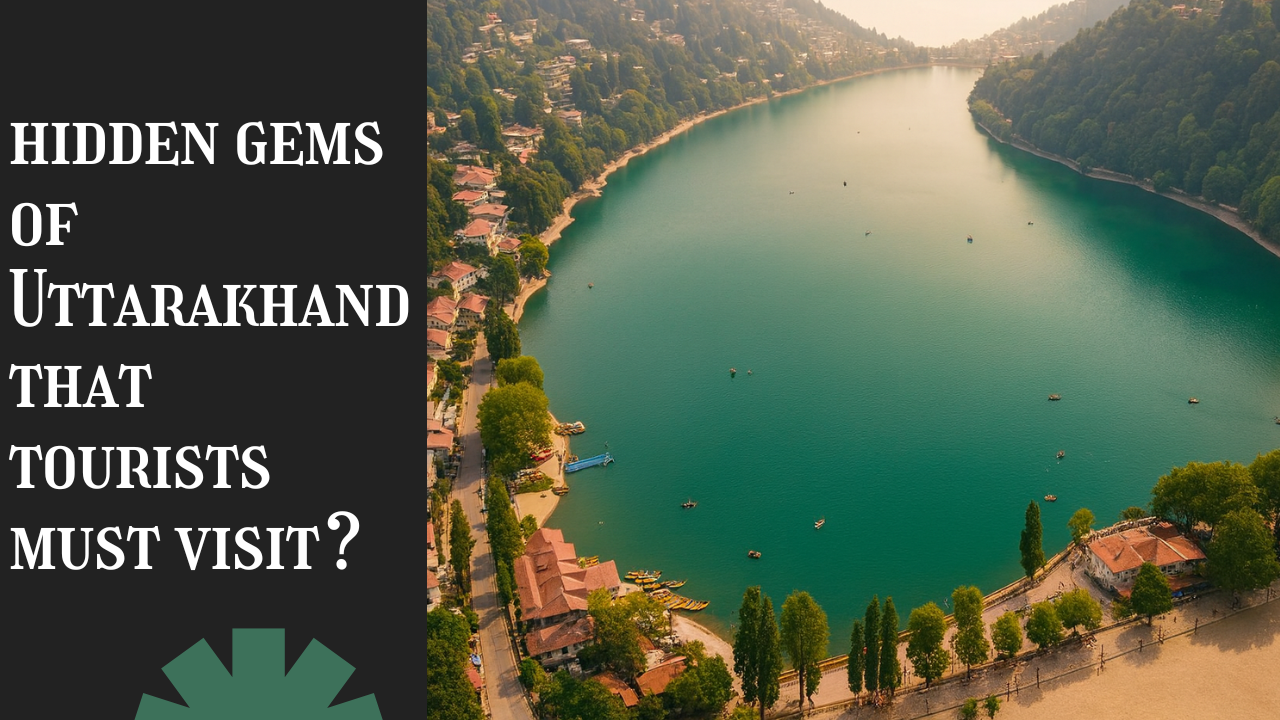Understanding Char Dham Yatra The word “Char Dham” is made up of two Hindi words — Char meaning four and Dham meaning temple or holy place. Therefore, Char Dham Yatra means the sacred journey to four divine shrines of India. Interestingly, India has two types of Char Dham pilgrimages. The first is the Main Char Dham, which includes Badrinath in Uttarakhand, Dwarkadhish in Gujarat, Jagannath Puri in Odisha, and Rameshwaram in Tamil Nadu. Each of these temples represents one direction of the country — north, west, east, and south — symbolizing the spiritual unity of India. However, the second type, known as the Chota Char Dham Yatra, is located entirely in Uttarakhand. This smaller yet spiritually powerful circuit attracts millions of pilgrims every year. Moreover, this Himalayan Char Dham includes Yamunotri, Gangotri, Kedarnath, and Badrinath, each holding deep mythological and cultural importance. You can also read our travel guide on Hidden Gems of Uttarakhand to explore lesser-known spiritual spots in the Himalayas. The Himalayan Char Dham – A Journey of Faith The Chota Char Dham Yatra unfolds through the Garhwal region of Uttarakhand, offering not only spiritual enlightenment but also breathtaking natural beauty. To begin with, the journey starts at Yamunotri, dedicated to Goddess Yamuna — believed to grant longevity and freedom from untimely death. Next comes Gangotri, where Goddess Ganga descended from heaven to cleanse humanity’s sins. After that, the path leads to Kedarnath, one of the twelve Jyotirlingas of Lord Shiva, where pilgrims often carry holy water from Gangotri to offer to the deity. Finally, the yatra concludes at Badrinath, devoted to Lord Vishnu, representing salvation and peace. Furthermore, each destination carries a unique story and spiritual vibration that deepens your connection with faith. It’s not just a route — it’s a path toward awakening. For updated temple timings and route maps, visit the official Uttarakhand Tourism website. 1. Follow the Trail of Myths and Legends Every temple in the Char Dham Yatra is rooted in ancient mythology. For example, Kedarnath is believed to be the place where the Pandavas sought Lord Shiva’s forgiveness after the Mahabharata war. Similarly, at Yamunotri, Goddess Yamuna is worshipped as the sister ohttp://bhjf Yama, the God of Death, and it is believed that bathing here ensures liberation from the fear of death. In addition, listening to these fascinating legends from local priests and villagers adds depth and wonder to your spiritual journey. As you travel, you realize that every mountain, river, and stone here has a story to tell. You may also like our blog on Is Rishikesh Just for Yoga? 10 Other Things You Didn’t Know You Could Do for exploring more spiritual activities in Uttarakhand. 2. Participate in Sacred Rituals While visiting these temples, don’t just observe — participate in the rituals. At Badrinath, many devotees perform Pind Daan or Shraddha rituals for their ancestors. Meanwhile, at Gangotri, people offer Tarpan to honor their departed loved ones in the sacred waters of the Ganga. Moreover, these age-old traditions bring emotional healing. They remind us that spirituality is not only about worshiping deities but also about staying connected to our roots and expressing gratitude for our lineage. 3. Discover Hidden Temples and Spots Beyond the four main shrines, several hidden gems await exploration. For instance, near Yamunotri, lies the Shani Dev Temple, known for its tranquil surroundings. Likewise, near Badrinath, you can visit Vasudhara Falls, where the cascading waters are believed to purify the soul. Additionally, visiting such lesser-known places gives you moments of peace away from the crowd, allowing you to connect deeply with nature and yourself. 4. Serve at Langars – The Joy of Seva Along the entire Char Dham route, you’ll find numerous langars (community kitchens) serving free meals to pilgrims. Volunteering at these langars — whether by cooking, serving food, or cleaning utensils — is a deeply humbling experience. It teaches you that seva (service) is another form of worship. Furthermore, helping others fills your heart with warmth and gratitude, reminding you that spirituality is best expressed through kindness. You can find volunteer opportunities listed on Badrinath-Kedarnath Temple Committee’s official website. 5. Explore the Origin of Sacred Rivers The Char Dham Yatra is not only about temples; it’s also about the rivers that give life to India. You can trek to Gaumukh Glacier, the origin of the River Ganga, or explore Saptrishi Kund, the source of the Yamuna River. These high-altitude treks are challenging yet profoundly rewarding. In addition, witnessing these origins helps you appreciate how faith and nature coexist. The sound of gushing waters and the sight of majestic peaks together create a moment of divine realization. 6. Chant Mantras by the Rivers At dusk, sit beside the riverbanks and chant “Om Namah Shivaya” or the Gayatri Mantra. The soothing sound of flowing rivers, the ringing temple bells, and the crisp mountain air together create an atmosphere of peace. Moreover, such meditation connects your soul with the divine energy that surrounds you. 7. Admire Himalayan Flora and Fauna The Char Dham route passes through valleys filled with vibrant Himalayan flora and fauna. You may encounter the Brahma Kamal, Uttarakhand’s state flower, near Badrinath, or spot Himalayan Monals and Musk Deer in higher regions. In addition, during spring, the entire valley blooms in shades of pink, yellow, and green, making the journey even more enchanting. Thus, the pilgrimage becomes a perfect balance between spiritual awakening and natural wonder. Learn more about the region’s biodiversity at Valley of Flowers National Park (UNESCO) 8. Join Eco-Friendly Activities Since thousands of devotees visit every year, maintaining cleanliness is crucial. Several local groups and NGOs organize clean-up drives and tree-planting campaigns along the yatra route. Participating in these initiatives is a small act with a big impact. Moreover, by contributing to nature’s preservation, you ensure that future generations experience the same serenity and beauty. 9. Meet the Himalayan Sages Throughout your journey, you may come across sages and hermits meditating in caves or living in solitude near the temples. Speaking
Hidden Gems of Uttarakhand That Tourists Must Visit
Hello friends! I’m Kanishka, and today I want to take you on a journey to some of the most beautiful and hidden gems of Uttarakhand. When we think of Uttarakhand, names like Mussoorie, Nainital, Rishikesh, and Haridwar usually come to mind. These are wonderful places, but they are often crowded. Sometimes, when we go to the mountains, we don’t just want sightseeing — we want peace, silence, and a chance to experience nature in its purest form. That’s exactly what Uttarakhand’s offbeat destinations offer. These hidden places are not on every tourist’s list, but trust me, they are worth visiting. From charming villages and untouched valleys to snow-covered meadows and birdwatching paradises, these spots will make you fall in love with the Himalayas all over again. So, let’s explore together the 10 hidden gems of Uttarakhand that every traveller must visit. 1. Chopta – The Mini Switzerland of India Chopta is a small but stunning hill station. Imagine green meadows, tall pine and deodar trees, and the cool mountain breeze. It is often called the Mini Switzerland of India. Chopta is also the starting point for the trek to Tungnath Temple, the highest Shiva temple in the world. If you love trekking, you can go a little further up to Chandrashila Peak, which gives one of the best views of the Himalayas. Whether it’s summer greenery or winter snow, Chopta is a paradise for adventure seekers, nature lovers, and even those who just want to relax. Best time to visit: March to May (pleasant weather) and December to February (snow). For trekking information, you can check the Uttarakhand Tourism Official Website. 2. Binsar – A Peaceful Retreat If you’re looking for silence and calmness, Binsar is the perfect choice. This small hill town near Almora is famous for the Binsar Wildlife Sanctuary. Bird lovers will be happy to know that over 200 species of birds can be spotted here. The best part of Binsar is the Zero Point, where you can enjoy a 360-degree view of the Himalayan peaks, including Nanda Devi and Trishul. On a clear day, the view looks straight out of a painting. Unlike crowded hill stations, Binsar gives you space to breathe, think, and simply enjoy nature. Best time to visit: October to March. 3. Khirsu – For Clear Himalayan Views Khirsu is a small village near Pauri, and it’s still not very popular among tourists. That’s what makes it special. The village is surrounded by oak, pine, and apple orchards. The best part about Khirsu is its unobstructed view of the Himalayas. On a clear day, you can see majestic peaks like Nanda Devi and Panchachuli shining bright. The air here is fresh, the atmosphere calm, and the people warm and welcoming. If you want to enjoy the mountains without the tourist rush, Khirsu should be on your list. Best time to visit: All year round. Learn about local culture on Incredible India. 4. Kanatal – A Calm Escape Near Mussoorie Most tourists stop at Mussoorie, but only a few go further to Kanatal. And that’s where the magic lies. Kanatal is quiet, less crowded, and surrounded by pine forests and apple orchards. It’s a great place for camping, nature walks, and adventure activities like valley crossing and rappelling. If you’re into spirituality, you can also trek to the famous Surkanda Devi Temple nearby. Kanatal is perfect for couples, families, or even solo travelers who want a peaceful holiday. Best time to visit: Throughout the year, especially winter for snow. 5. Munsiyari – Little Kashmir of Uttarakhand Munsiyari is one of the most beautiful hidden gems in Uttarakhand. Located in the Pithoragarh district, it is often called the Little Kashmir of Uttarakhand. The main attraction here is the Panchachuli Peaks, a group of five snow-covered mountains. Sunrise and sunset views here are unforgettable. Munsiyari is also the starting point for treks to Milam and Ralam Glaciers. This place is perfect for photographers, trekkers, and anyone who wants to see raw Himalayan beauty. Best time to visit: March to June and September to October. 6. Pangot – Paradise for Bird Lovers If you love birds, Pangot is the place for you. Located just 15 km from Nainital, this small village is home to more than 300 species of birds. From Himalayan griffons to colorful pheasants, you’ll see a variety of birds here. Pangot is also great for short treks, peaceful stays, and nature walks. Unlike Nainital, which is always busy, Pangot remains quiet and relaxed. Best time to visit: October to June. 7. Khati Village – On the Way to Pindari Glacier Khati is the last inhabited village on the trek to Pindari Glacier. This small Kumaoni village has wooden houses, simple lifestyles, and welcoming people. Staying in Khati feels like stepping back in time. It’s a wonderful way to experience local culture and village life in the Himalayas. For trekkers, Khati is also an important stop before moving further towards the glacier. Best time to visit: April to June and September to October. 8. Harsil – An Untouched Valley On the way to Gangotri lies Harsil, a small but stunning valley. It is known for its apple orchards, riverside beauty, and peaceful environment. Unlike other touristy places, Harsil still feels untouched. You can sit by the Bhagirathi River, enjoy the mountain views, and feel the fresh air filling your lungs. Harsil is also a great base for exploring Gangotri, but many travelers stay here just for its beauty. Best time to visit: May to October. 9. Kausani – Switzerland of India Kausani is often called the Switzerland of India because of its breathtaking views. From here, you can see a 300 km wide view of the Himalayan peaks like Nanda Devi, Trishul, and Panchachuli. Mahatma Gandhi once stayed here and said Kausani was the best place for silence and reflection. Apart from the views, you can also explore tea gardens and small local markets. Best time to visit: September to May. 10. Mana Village



